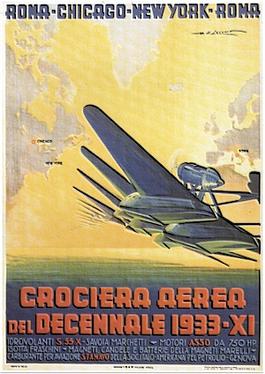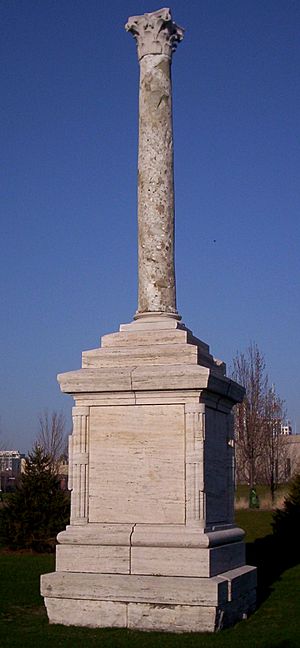Italo Balbo facts for kids
Quick facts for kids
Marshal
Italo Balbo
|
|
|---|---|
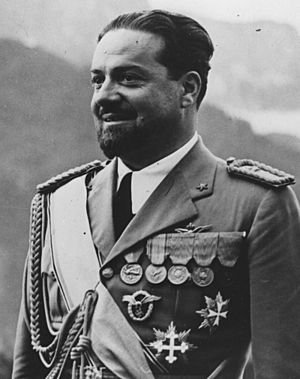 |
|
| Governor-General of Italian Libya | |
| In office 1 January 1934 – 28 June 1940 |
|
| Preceded by | Office created |
| Succeeded by | Rodolfo Graziani |
| Minister of the Air Force | |
| In office 12 September 1929 – 6 November 1933 |
|
| Prime Minister | Benito Mussolini |
| Preceded by | Benito Mussolini |
| Succeeded by | Benito Mussolini |
| Quadrumvir in the Grand Council of Fascism |
|
| In office 12 January 1923 – 28 June 1940 Serving with Michele Bianchi (d. 1930), Emilio De Bono, Cesare Maria De Vecchi
|
|
| Member of the Chamber of Deputies | |
| In office 24 May 1924 – 2 March 1939 |
|
| Constituency | Emilia-Romagna |
| Personal details | |
| Born | 6 June 1896 Ferrara, Kingdom of Italy |
| Died | 28 June 1940 (aged 44) Tobruk, Italian Libya |
| Political party | Italian Fasces of Combat (1919–1921) National Fascist Party (1921–1940) |
| Spouse |
Emanuela Florio
(m. 1924) |
| Children | 3 |
| Military service | |
| Allegiance | |
| Branch/service | MVSN Regia Aeronautica |
| Years of service | 1915–1940 |
| Rank | Maresciallo dell'Aria (Marshal of the Air Force) |
| Battles/wars | World War I: |
Italo Balbo (born June 6, 1896 – died June 28, 1940) was an important Italian politician and military leader. He was a key figure in the Fascist movement. He served as Italy's Marshal of the Air Force and later as the Governor-General of Libya. He was also the Commander-in-Chief of Italian forces in North Africa. Because he was quite young for such high positions, some people thought he might even become the next leader after Benito Mussolini.
After fighting in World War I, Balbo became a top organizer for the National Fascist Party in his home area of Ferrara. He was one of the four main leaders, called Quadrumviri del Fascismo, who planned the March on Rome in 1922. This event brought Mussolini and the Fascists to power. In 1926, he helped create the Italian Royal Air Force and became famous for promoting aviation. In 1933, he was made Governor of Italian Libya, where he lived until his death. Balbo was one of the few Fascist leaders who disagreed with Mussolini's alliance with Nazi Germany. He was accidentally killed by his own country's anti-aircraft guns during World War II when his plane was shot down over Tobruk.
Contents
Early Life and Military Service
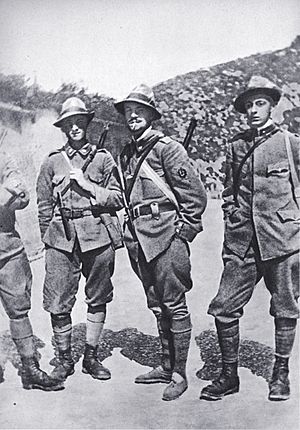
Italo Balbo was born in Quartesana, near Ferrara, Italy, in 1896. He was interested in politics from a young age. When he was 14, he tried to join a rebellion in Albania.
When World War I started, Italy first stayed neutral. Balbo strongly believed Italy should join the war on the side of the Allies. After Italy entered the war in 1915, Balbo joined the Italian Royal Army as an officer. He served with the Alpini mountain infantry. He showed great courage and earned several medals for his bravery. By the end of the war, he had reached the rank of Captain.
After the war, Balbo finished his studies. He earned degrees in law and social sciences. He was a Republican but disliked socialists and their unions. He then worked as a bank clerk in his hometown.
Becoming a Fascist Leader
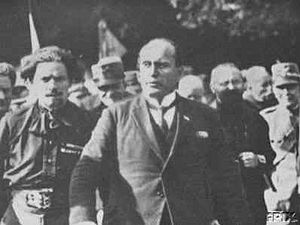
In 1921, Balbo joined the new National Fascist Party. He quickly became an important organizer for the party in Ferrara. He formed his own group of Fascist supporters. They were known for breaking strikes and attacking communists and socialists.
By 1922, Italo Balbo was one of the "Ras" of the Fascist party. This was a title for local leaders, similar to a duke. At just 26 years old, Balbo was the youngest of the "Quadrumvirs". These were the four main planners of the "March on Rome". This event was a big march that helped the Fascists take control of Italy. The other Quadrumvirs were Michele Bianchi, Cesare Maria De Vecchi, and Emilio De Bono. Benito Mussolini himself did not take part in the march.
In 1923, Balbo became a founding member of the Grand Council of Fascism. This was an important body in the Fascist government. He later became the General Commander of the Fascist militia.
Aviation Pioneer
On November 6, 1926, Balbo was made Secretary of State for Air. Even though he had little flying experience, he quickly learned to fly. He then began building up the Italian Royal Air Force (Regia Aeronautica Italiana). By 1929, he became the Minister of the Air Force.
This was an exciting time for aviation in Italy. Other Italian aviators were also making famous flights. Balbo himself led several impressive transatlantic flights. His first major flight was in 1930. He led twelve Savoia-Marchetti S.55 flying boats from Italy to Rio de Janeiro, Brazil.
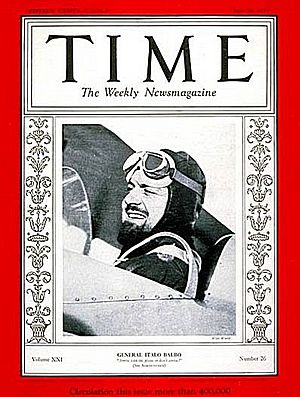
His most famous flight was in 1933, called the Crociera del Decennale. Twenty-four seaplanes flew from Rome to Chicago, Illinois, and back. They stopped in places like Amsterdam, Iceland, and Canada. In Chicago, they landed on Lake Michigan. To celebrate this amazing feat, Mussolini gave Chicago a column from an ancient Roman site. This column, known as the Balbo Monument, is still in Chicago today. Chicago also renamed a street "Balbo Drive" and held a big parade for him.
From Chicago, Balbo and his pilots flew to New York City. They received a huge welcome there. Millions of people watched a parade in their honor on Broadway (Manhattan). Balbo even appeared on the cover of Time magazine.
During his visit to the United States, President Franklin Roosevelt met with Balbo. He was also honored by the Sioux tribe, who called him "Chief Flying Eagle." Balbo was very popular with Italian-Americans. He told them to be proud of their Italian heritage. The term "Balbo" even became a common word for a large group of airplanes flying together.
After returning to Italy, Balbo was promoted to the new rank of Marshal of the Air Force. He suggested making the Italian army smaller but stronger. He wanted it to be ready for quick deployments by sea or train. However, this plan was too expensive.
Governor of Libya
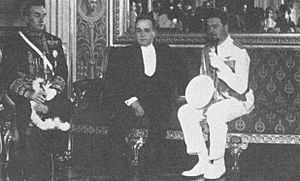
On November 7, 1933, Balbo was appointed Governor-General of the Italian colony of Libya. This was a very important job. Mussolini wanted Balbo to help expand Italy's influence in Africa. Balbo's goal was to secure more land for Italy in areas leading to Lake Chad and the Sudan. Mussolini even dreamed of Italy controlling parts of Cameroon and having a port on the Atlantic Ocean.
Balbo moved to Libya and merged the different regions into one colony. Some people believe Mussolini sent Balbo to Libya to keep him away from politics in Rome. Balbo was very famous, and Mussolini might have seen him as a rival.
Balbo started building new roads, like the Via Balbia, to encourage Italians to move to Libya. He also tried to get Muslims to support the Fascist cause. In 1938, Balbo was the only Fascist leader who strongly disagreed with the new laws against Jewish people.
World War II and His Death
In 1939, after Germany invaded Poland, Balbo went to Rome. He told Mussolini he was unhappy about Italy supporting Adolf Hitler. Balbo was the only high-ranking Fascist to openly criticize Mussolini's alliance with Nazi Germany. He believed Italy should side with the United Kingdom. When he heard about Italy's formal alliance with Germany, he reportedly said, "You will all wind up shining the shoes of the Germans!"
When Italy declared war on June 10, 1940, Balbo was the Governor-General of Libya. He was also the Commander-in-Chief of Italian forces in North Africa. He was in charge of planning an invasion of Egypt.
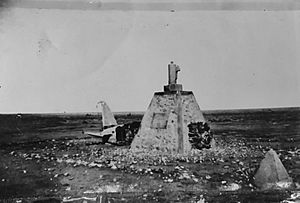
On June 28, 1940, Balbo was flying in a Savoia-Marchetti SM.79 plane. He was heading to the airfield in Tobruk, Libya. British planes had just attacked the airfield. Italian anti-aircraft guns defending the airfield mistakenly thought Balbo's plane was British. They opened fire as it tried to land. The plane was shot down, and everyone on board died.
An eyewitness reported that an Italian cruiser, the San Giorgio, started firing first. Then the airfield's anti-aircraft guns joined in. It is still not clear which guns caused the plane to crash. Most people agree that it was a tragic accident. Balbo's plane was flying low and against the sun, making it hard to identify.
When the British Royal Air Force heard about Balbo's death, they sent a plane to drop a wreath over the Italian airfield. The note expressed sympathy for the loss of "a great leader and gallant aviator."
Balbo was buried near Tripoli. In 1970, his family moved his remains back to Italy. They reburied him in Orbetello after Muammar Gaddafi threatened to disturb Italian cemeteries in Tripoli.
Legacy and Memorials
In 1933, Benito Mussolini gave the city of Chicago a monument to Balbo. "Balbo Drive" is still a well-known street in downtown Chicago. In 2017, there was a campaign to rename it. Instead, the city decided to rename another street, Congress Parkway, in honor of Ida B. Wells. She was a famous journalist and activist from Chicago.
In Italy, after the Fascist government ended, most monuments and streets named after Balbo were changed back to their old names. Or they were renamed after people who fought against the Fascists.
See also
 In Spanish: Italo Balbo para niños
In Spanish: Italo Balbo para niños
- Aozou Strip
- Military history of Italy during World War II
- Squadrismo
- Via Balbia


